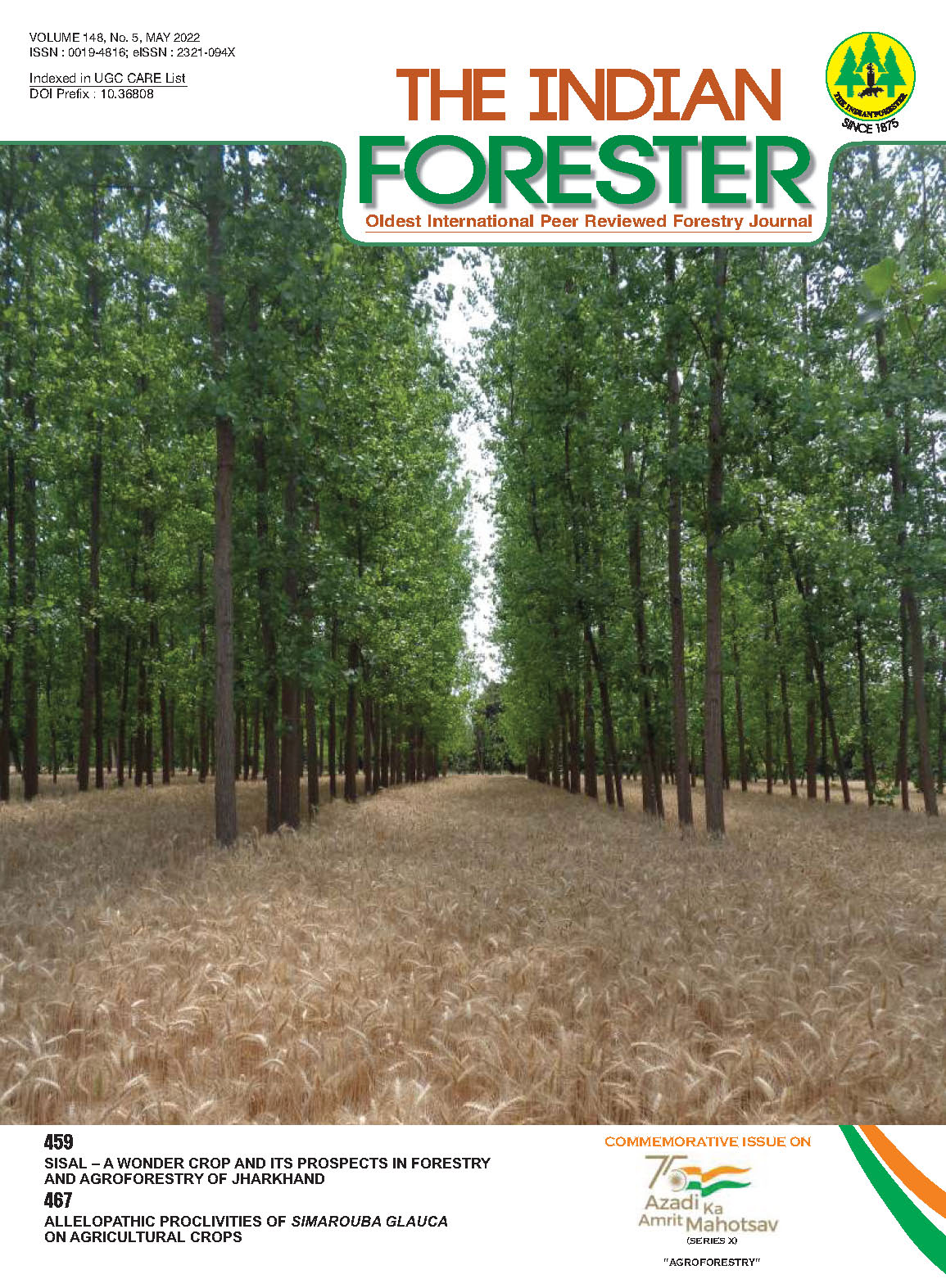Status of Private Plantation and their Management in Siraha distict of Nepal: A case study
DOI:
https://doi.org/10.36808/if/2022/v148i5/159354Keywords:
Private forest, Selling procedure, Commercial species, Timber flowAbstract
The research work was conducted to find out the status of private forests with the major species planted and managed in the Terai. Additionally, the present status of private forests and the scenarios of selling procedure, and the silviculture practices that are applied, were studied and form a basis on which further research could be carried out. The research is based on a descriptive and field survey. The serious issue recognized that upset the private forest improvement was the absence of land accessibility, lack of seedling of the desired tree species, absence of specialized information, absence of fitting business sector and market cost, and inappropriate timber utilization. The discoveries additionally incorporate that an uncommonly moderate pace of private forest registration, long and multi-stage forms for getting, collecting and transportation licenses and authority bans on significant commercial species, among others, are seen as the variables that most ruin the private forest proprietors and tree producers interest and their advantages and obligations concerning the association and utilization of their private forest assets. It is concluded that a disentangled allowing process would elevate and assist private forestry.
References
Acharya D. and Baral N.R. (2017) Neglected High Altitude Rangelands of Nepal: Need for Reform. Journal of Forest and Livelihood, 15(1): 103-119.
Amatya S.M. and Lamsal P. (2017). Private Forests in Nepal: Status and Policy Analysis. J For Livelihood, 15(1): 120-130. https://doi.org/10.3126/jfl.v15i1.23094
Aryal K., Rijal A., Maraseni T. and Parajuli M. (2020). Why is the Private Forest Program Stunted in Nepal? Env Mgmt., 66(4): 535-548. https://doi.org/10.1007/s00267-020-01343-z
Bhattarai B. (2014). Private forest for economic opportunity in mountainous region of Nepal. In: The World Bank and Thai Nguyen University (eds), Sustainable development and ethnic minority poverty reduction in mountainous regions. Thai Nguyen University Publishing House, Thailand.
Cedamon E., Nuberg I., Pandit B.H. and Shrestha K.K. (2018). Adaptation factors and futures of agroforestry systems in Nepal. Agrofor Syst., 92: 1437-1453. https://doi.org/10.1007/s10457- 017-00909
Chhetri B.K, Rayamajhi S., Tiwari K.R. and Sitaul B.K. (2017). Importance of trees outside forest (Tof) in Nepal: a review. Octa J Environ Res., 5: 70-81
DOF. (2018). Community forestry bulletin. Department of Forests (DOF), Kathmandu, Nepal.
FAO. (2015) Global Forest Resources Assessment. FAO, Rome, Italy. ISBN, 978-92-5-108826-5. www.fao.org/forestry/fra.
Finley A.O. and Kittredge D.B. (2006). Thoreau, Muir, and Jane Doe: different types of private forest owners need different kinds of forest management. North J Appl For., 23: 27-34. https://doi.org/10. 1093/njaf/23.1.27
Fisher R.J. and Malla Y.B. (1987). Forestry work in villages: A guide for field workers, Technical Note 3/87. Kathmandu, Nepal-Australia Forestry Project.
GON. (2011). Private Forest Development Directives 2011. Ministry of Forests and Soil Conservation, Government of Nepal, Kathmandu, Nepal.
GON. (2019). Forest Act 2019. Government of Nepal, Kathmandu, Nepal.
Hemstrom K., Mahapatra K. and Gustavsson L. (2013). Swedish private forest owners' perceptions and intentions with respect to adopting exotic tree species. Eur J for Res., 132: 433- 444. https://doi.org/ 10.1007/s10342-013-0682-5
Maraseni T.N. (2008). Selection of non-timber forest species for community and private plantations in the high and low altitude areas of Makawanpur District, Nepal. Small-Scale For., 7: 151161. https://doi.org/10.1007/s11842-008-9047-1
Maraseni T.N., Son H.L., Cockfield G., Duy H.V. and Nghia T.D. (2017) Comparing the financial returns from acacia plantations with different plantation densities and rotation ages in Vietnam. For Pol Econ., 83(C): 80-87.
Oli B.N., Treue T. and Smith-Hall C. (2016). The relative importance of community forests, government forests, and private forests for household-level incomes in the middle hills of Nepal. For Policy Econ., 70: 155-163. https://doi.org/10.1016/j.forpol.2016. 06.026
Pandit B.H, Neupane R.P, Sitaula B.K. and Bajracharya R.M. (2013). Contribution of smallscale agroforestry systems to carbon pools and fluxes: a case study from middle hills of Nepal. Small-Scale For., 12: 475-487. https://doi.org/10.1007/s11842012-9224-0
Paudel M. (2016). Growing interest in private forestry. The Kathmandu Post. Retrieved May 22, 2020. https://kathmandupost.com/national/2016/08/26/growinginterest-in-private-forestry
Regmi B.N. and Garforth C. (2010). Trees outside forests and rural livelihoods: a study of Chitwan District, Nepal. Agrofor Syst., 79: 393-407. https://doi.org/10.1007/s10457-010-92920
Subedi B.P., Ghimire P.L., Koontz A., Khanal S.C., Katwal P., Sthapit K.R. and Mishra S.K. (2014). Private Sector Involvement and Investment in Nepal's Forestry: Status, Prospects and Ways Forward. Study report, Multi Stakeholder Forestry Programme - Services Support Unit, Babarmahal, Kathmandu, Nepal.
Zmihorski M., Chylarecki P., Rejt L. and Mazgajski T.D. (2010). The effects of forest patch size and ownership structure on tree stand char-acteristics in a highly deforested landscape of central Poland. Eur J For Res., 129: 393-400. https://doi.org/10.1007/s10342-009-0344-9.
Downloads
Downloads
Published
How to Cite
Issue
Section
License
Unless otherwise stated, copyright or similar rights in all materials presented on the site, including graphical images, are owned by Indian Forester.





